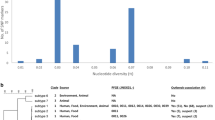Abstract
This study describe the use of a combination of two recently proposed typing approaches, multiple amplification of prophage locus typing (MAPLT) and multiple-locus variable-number tandem-repeat analysis (MLVA) for subdividing within Salmonella enterica serovar Heidelberg (S. Heidelberg). The combined typing method was compared with pulsed-field gel electrophoresis (PFGE) by Simpson’s index of diversity (DI). PFGE was shown to have a DI = 0.84 and was poor at differentiation of the predominant PT1 (Phage Type 1) phenotype. In comparison, the combined MAPLT/MLVA method comprising 3 MLVA and 9 MAPLT primer pairs provided a higher differentiating ability DI = 0.92. More importantly, the combined methodology was found to be superior in the differentiation of the predominant PT1 isolates. In conclusion, this study demonstrated the potential of the rapid and simple amalgamated MAPLT/MLVA approach in determining transmission of isolates of clonal phage type groups from various environmental sources to humans.


Similar content being viewed by others
References
Australian Salmonella Reference Centre. Annual Reports 1986–2009. Institute of Medical and Veterinary Science, Adelaide
Centers for Disease Control and Prevention. National Antimicrobial Resistance Monitoring System for Enteric Bacteria (NARMS): Human Isolates Final Reports, 2005–2008. Department of Health and Human Services, Atlanta
Lindstedt B-A, Heir E, Gjernes E, Kapperud G (2003) DNA fingerprinting of Salmonella enterica subsp. enterica serovar typhimurium with emphasis on phage type DT104 based on variable number of tandem repeat loci. J Clin Microbiol 41(4):1469–1479
Chittick P, Sulka A, Tauxe RV, Fry AM (2006) A summary of national reports of foodborne outbreaks of Salmonella Heidelberg infections in the United States: clues for disease prevention. J Food Prot 69:1150–1153
Currie A, MacDougall L, Aramini J, Gaulin C, Ahmed R, Isaacs S (2005) Frozen chicken nuggets and strips and eggs are leading risk factors for Salmonella Heidelberg infections in Canada. Epidemiol Infect 133:809–816
Demczuk W, Soule G, Clark C, Ackermann H-W, Easy R, Khakria R, Rodgers F, Ahmed R (2003) Phage-based typing scheme for Salmonella enterica serovar Heidelberg, a causative agent of food poisonings in Canada. J Clin Microbiol 41:4279–4284
Hennessy TW, Cheng LH, Kassemborg H, Angulo SD, Mohle-Boetani J, Marcus R, Shiferaw B, Angulo FJ (2004) Egg consumption is the principal risk factor for sporadic Salmonella serotype Heidelberg infections: a case-control study in FoodNet sites. Clin Infect Dis. 38(Suppl 3):237–243
Harvey D, Harrington C, Heuzenroeder MW, Murray C (1993) Lysogenic phage in Salmonella enterica serovar Heidelberg (Salmonella heidelberg): implications for organism tracing. FEMS Microbiol Lett 108:291–293
Ross IL, Heuzenroeder MW (2005) Discrimination within phenotypically closely related definitive types of Salmonella enterica serovar typhimurium by the multiple amplification of phage locus typing technique. J Clin Microbiol 43:1604–1611
Zhao S, White DG, Friedman SL, Glenn A, Blickenstaff K, Ayers SL, Abbott JW, Hall-Robinson E, McDermott PF (2008) Antimicrobial resistance in Salmonella enterica serovar Heidelberg isolates from retail meats, including poultry, from 2002 to 2006. Appl Environ Microbiol 74:6656–6662
Boxrud D, Pederson-Gulrud K, Wotton J, Medus C, Lyszkowicz E, Besser J, Bartkus JM (2007) Comparison of multiple-locus variable-number tandem repeat analysis, pulsed-field gel electrophoresis, and phage typing for subtype analysis of Salmonella enterica serotype Enteritidis. J Clin Microbiol 45(2):536–543
Broschat SL, Call DR, Davis MA, Meng D, Lockwood S, Ahmed R, Besser TE (2010) Improved identification of epidemiologically related strains of Salmonella enterica by use of a fusion algorithm based on pulsed-field gel electrophoresis and multiple-locus variable-number tandem-repeat analysis. J Clin Microbiol 48:4072–4082
Ross IL, Heuzenroeder MW (2009) A comparison of two PCR-based typing methods with pulsed-field gel electrophoresis in Salmonella enterica serovar Enteritidis. Int J Med Microbiol 299:410–420
Maslow JN, Slutsky AM, Arbeit RD (1993) The application of pulsed-field gel electrophoresis to molecular epidemiology. In: Persing DH, Smith TF, Tenover FC, White TJ (eds) Diagnostic molecular microbiology: principles and applications. American Society of Microbiology, Washington, DC, pp 563–572
Tenover FC, Arbeit RD, Georing R, Mickelsen PA, Murray BE, Persing DH, Swaminathan B (1995) Interpreting chromosomal DNA restriction patterns produced by pulsed-field gel electrophoresis: criteria for bacterial strain typing. J Clin Microbiol 33:2233–2239
Witonski D, Stefanova R, Ranganathan A, Schutze GE, Eisenach KD, Cave MD (2006) Variable-number tandem repeats that are useful in genotyping isolates of Salmonella enterica subsp. enterica serovars typhimurium and Newport. J Clin Microbiol 44:3849–3854
Ross IL, Heuzenroeder MW (2008) A comparison of three molecular typing methods for the discrimination of Salmonella enterica serovar Infantis. FEMS Immunol Med Microbiol 53:375–384
Hunter PR, Gaston MA (1988) Numerical index of the discriminatory ability of typing systems: an application of Simpson’s index of diversity. J Clin Microbiol 26:2465–2466
Ramisse V, Houssu P, Hernandez E, Denoeud F, Hilaire V, Lisanti O, Ramisse F, Cavallo J-D, Vergnaud G (2004) Variable number of tandem repeats in Salmonella enterica subsp. enterica for typing purposes. J Clin Microbiol 42:5722–5730
Lindstedt B-A, Vardund T, Aas L, Kapperud G (2004) Multiple-locus variable-number tandem-repeats analysis of Salmonella enterica subsp. enterica serovar typhimurium using PCR multiplexing and multicolour capillary electrophoresis. J Microbiol Method 59(3):163–172
Public Health Agency of Canada (2006) Laboratory surveillance data for enteric pathogens in Canada: annual summary 2006. The Canadian Science Centre for Human and Animal Health, Winnipeg
Acknowledgments
We thank Ms. Dianne Davos, Ms. Helen Hocking and the staff of the Australian Salmonella Reference Centre, Adelaide for providing typed isolates for this study. We also thank the National Health and Medical Research Council for their financial support for this work.
Conflict of interest
The authors declare that they have no conflict of interest.
Author information
Authors and Affiliations
Corresponding author
Rights and permissions
About this article
Cite this article
Young, CC., Ross, I.L. & Heuzenroeder, M.W. A New Methodology for Differentiation and Typing of Closely Related Salmonella enterica serovar Heidelberg Isolates. Curr Microbiol 65, 481–487 (2012). https://doi.org/10.1007/s00284-012-0179-3
Received:
Accepted:
Published:
Issue Date:
DOI: https://doi.org/10.1007/s00284-012-0179-3




